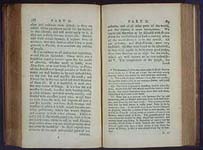Mitchell, John
The Present State of Great Britain and North America, With Regard to Agriculture, Population, Trade, and Manufacturers, Impartially Considered . . . London. 1767. 363 pp. With errata sheet.


This detailed analysis of " . . . the dearth and scarcity of the neccessaries of life in England; the want of staple commodities in the colonies; the decline of their trade; increase of people and necessity of manufactures; as well as of a trade in them hereafter," offers a series of causes and consequences for the "growing evils" that affect relations between Great Britain and the North American colonies. Mitchell argues that many of the problems in Great Britain are due to the increase in towns and the subsequent decrease in husbandmen and agricultural laborers. He believes that the American colonies are of great necessity to the improvement of conditions in Great Britain and the proper regulation of the Colonies, including taxes, are considered and compared. Mitchell divides the colonies into three main areas and discusses the dimensions, soil and climate, products, staple commodities, agriculture and manufacturing capabilities of each area.
Mitchell describes the Southern colonies, including the territory of Florida, at great length. Mitchell places great importance on the Southern colonies and their ability to provide for the motherland. He argues, "it is only in the Southern parts of North America, that the colonies can either make those commodities which are so much wanted by the nation ... The interest of the nation therefore lies in the Southern parts of that Continent, and it is only by cultivating these, that Britain will be ale to keep her colonies in a state of dependence on her, or reap any great advantages by them." However, optimism with regard to the potential of Florida to contribute to the agricultural and economic needs of Great Britain is noticeably lacking. He writes: "The settlement of Florida is the direct way to disappoint the nation in everything we want from North America. ... It is to the wretched sterility of these Southern coasts of America, which will neither produce any thing, nor breed people to reap their products, that all these disappointments, and the bad state of the nation, are owing; and the settlement of Florida, which is so much worse than any of the rest, will only increase these evils, and render them perpetual." Mitchell continues with medical observations about the Florida area:
The few people who were maintained there at a public expence, who were mostly forçados or convicts banished to a forlorn desert, were not able to get the bare necessaries of life . . .Therefore whatever any may say about the healthfulness or fruitfulness of Florida, it must appear to be mere conjecture, contrary to 170 years experience . . . It is as contrary to all reason and experience, to call Florida healthful. There never was a healthful country known along the sea coasts of America . . . It is a low, flat marshy sea coast, scorched with burning lands, in a hot climate, and close woody country, and flooded with heavy rains, which have no drain from the land, but stagnate all over a low flat country and form those swamps and marches of which it is full; which become perfectly pestiferous, where the waters stagnate and corrupt in such a hot climate.
Mitchell held out little hope for Great Britain's ability to populate Florida, and agricultural productivity seemed a distant dream.
The complextions of the people, the surest sign of the state of health in any country, their pale and sallow looks, and emaciated habits abundantly shew the unhealthfulness of their situation, and deter all who know them from settling among them . . . They look upon it as going to their graves, or to lead a miserable life in an intemperate and sickly climate, in which they are not able to undergo the labor that is neceesary to earn their bread . . . If we consider the soil, it is rather worse than the climate or situation. All the Southern and maritime parts of North America are either a barren bank of sand, or an unhealthful sunken marsh; and the farther south we go, the worse it grows in these respects, till in Florida it ends in a mere sandy desert full of stagnant pools from the heavy rains.
John Mitchell is considered to be a true Renaissance man. Educated at Cambridge, he became a physician, botanist, author, and creator of one of the most famous maps of North America. Mitchell emigrated to America in the early 1700s and worked as a physician to the poor. His research into the treatment of yellow fever established his reputation in the medical field, while his botanical work earned his election into the Royal Society and an American plant was named in his honor. As a biologist, Mitchell studied the embryology of the opossum, while as a chemist he researched methods for producing potash. His most important work, however, was the great map that he commenced work on in 1750 and published in 1755. His "Map of the British and French Dominions in North America with the Roads, Distances, Limits, and Extent of the Settlements," was created under a commission from the Earl of Halifax to determine the English territorial rights in North America. The map was devised as a cartographic rebuttal to the French boundary claims proposed on maps prior to the French and Indian war and it distinguishes British and French possessions in eastern North America. Twenty-one editions of Mitchell's map appeared in four languages between 1755 and 1781. A copy of the third edition was used by John Jay during the negotiations for the 1783 Treaty of Paris. The map was used as evidence as late as 1932 during the Delaware-New Jersey dispute.